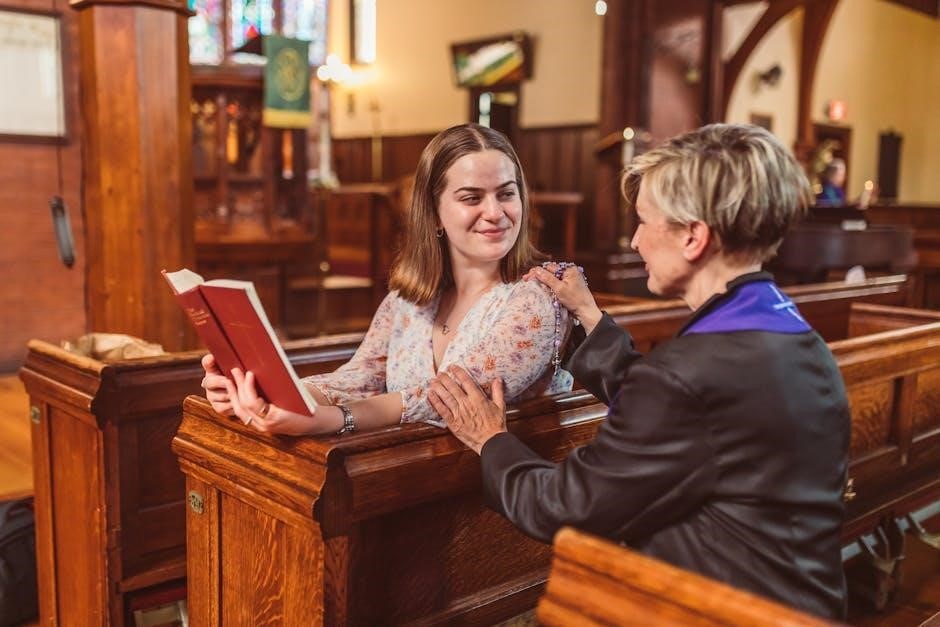This book by James Allen, Hilton Als, and Congressman John Lewis confronts America’s dark history of racial violence through haunting lynching photographs. It serves as a critical historical document, revealing the brutal reality of racial terror from 1882 to 1968. The collection of images and essays provides a powerful visual and narrative record of this painful era. While the book is not available for download as a PDF due to copyright restrictions, it can be accessed online through various platforms or read via specific apps, ensuring its important message reaches modern audiences.
1.1 Overview of the Book
“Without Sanctuary: Lynching Photography in America” is a profound historical document that exposes the brutal reality of racial violence in the U.S. through photographs and essays. Compiled by James Allen, the book features chilling images of lynchings from 1882 to 1968, alongside contributions from Hilton Als and Congressman John Lewis. It serves as a visual testament to the horrors of racial terror, offering a harrowing glimpse into America’s past. The book is available for online reading but not as a downloadable PDF.
1.2 Author Background: James Allen
James Allen, an Atlanta-based antiques dealer and historian, is the collector behind the haunting photographs in “Without Sanctuary.” His deep interest in American history led him to compile these disturbing images, which document racial violence and lynchings from 1882 to 1968. Allen’s work sheds light on a painful era, providing a visual record of racial terror in America. His efforts have made him a key figure in preserving this history, ensuring its lessons are not forgotten.
1.3 Historical Context of Lynchings in America
Lynching in America, spanning from 1882 to 1968, was a tool of racial terror, primarily targeting African Americans. This era of violence was rooted in post-Civil War tensions, Reconstruction failures, and the rise of Jim Crow laws. Lynching became a means to enforce racial hierarchy and control, often justified by false accusations. The practice was widespread, with over 4,743 documented cases. These acts of violence were frequently photographed and distributed as postcards, normalizing racial brutality and perpetuating fear within Black communities.

The Importance of the Book
Without Sanctuary is a crucial historical document exposing racial violence in America. It provides visual evidence of lynching, preserving painful truths for educational and reflective purposes.
2.1 Documenting Racial Violence in America
Without Sanctuary meticulously documents the horrific reality of racial violence in America, focusing on the era of lynching from 1882 to 1968. The book compiles 4,743 documented cases, showcasing the brutal reality through photographs and postcards. These images, often used as souvenirs, reveal the shocking normalization of lynching in American society. By preserving these records, the book serves as a chilling reminder of systemic racial terror and its lasting impact on the nation’s history and racial justice discussions.
2.2 The Role of Photography in Preserving History
Photography plays a crucial role in preserving history, as seen in Without Sanctuary. The book uses harrowing images to document lynching in America, transforming these photographs into vital historical evidence. These visuals capture the brutality of racial violence, providing an unflinching record of atrocities often erased or denied. By making these images accessible, the book ensures that future generations confront and learn from this painful past, highlighting photography’s power to preserve and educate about history’s darkest chapters.
2.3 Impact on Racial Justice Discussions
Without Sanctuary has significantly influenced racial justice discussions by exposing the brutal reality of lynching in America. The book’s harrowing photographs and essays provide a visual and emotional record of racial violence, making the history of lynching tangible and undeniable. This exposure has sparked urgent conversations about race, justice, and systemic inequality. By confronting the past, the book serves as a catalyst for dialogue and activism, urging readers to address the ongoing legacy of racial injustice in America.

Key Themes and Content
The book explores the horror of lynching, the emotional toll on victims’ families, and the societal norms that enabled racial violence in America.
3.1 The Horror of Lynching: A Photographic Record
Without Sanctuary presents a harrowing visual archive of lynching in America, capturing the brutal reality of racial violence through graphic photographs. These images, collected by James Allen, document the atrocities committed between 1882 and 1968, exposing the cruelty and inhumanity of racial terror. The photographs reveal the shocking normalization of lynching, often celebrated in postcards, and the devastating emotional toll on victims’ families and communities. This photographic record serves as a chilling reminder of America’s dark past and its ongoing impact.
3.2 The Collection of Lynching Photographs
James Allen’s collection in Without Sanctuary comprises over 150 lynching photographs, meticulously gathered from flea markets and auctions. These images, often originally used as postcards, reveal the disturbing normalization of racial violence. The collection includes descriptions and historical context, providing a poignant record of America’s racial terror era. While the book is not downloadable as a PDF, its availability online ensures access to this vital historical documentation, preserving the memories of victims and fostering ongoing discussions about racial justice and equality.
3.3 The Emotional and Psychological Toll of Lynching
The book vividly captures the profound emotional and psychological trauma inflicted by lynching on victims, their families, and entire communities. The graphic images and personal stories reveal the terror, pain, and long-lasting scars left by these brutal acts. The collection emphasizes how such violence was not only physical but also deeply psychological, perpetuating fear and racial oppression. This section underscores the human cost of lynching, making it a powerful tool for understanding the enduring impact of racial violence in America.

Historical Context of Lynching in America
This section explores the historical backdrop of lynching in America, detailing the era of racial terror from 1882 to 1968 and societal norms enabling such violence.
4.1 The Era of Racial Terror (1882-1968)
This period, documented in Without Sanctuary, marks the peak of racial violence in America, with over 4,743 documented lynchings. These acts of terror, often publicly spectated, were tools of white supremacy, aimed at intimidating African Americans and enforcing racial hierarchy. The era saw brutal violence justified by false accusations, perpetuating fear and subjugation. This dark chapter laid the groundwork for the civil rights movement, as communities sought justice and an end to systemic oppression.
4.2 The Role of Postcards in Promoting Lynchings
Lynching postcards, featured in Without Sanctuary, were disturbingly common, circulating graphic images of racial violence. These postcards, often mailed as souvenirs, glorified lynching and reinforced racial hatred. They were tools of propaganda, normalizing brutality and spreading white supremacist ideology. The images were shared widely, desensitizing society to the atrocities and perpetuating a culture of fear and oppression.
4.3 The Societal Norms That Enabled Lynching
Lynching was perpetuated by deeply entrenched racial prejudices and societal norms that dehumanized Black Americans. White supremacy was normalized, making lynching a public spectacle that reinforced racial hierarchy. The lack of legal consequences and widespread public acceptance allowed this violence to persist. Without Sanctuary exposes how these norms were ingrained in American culture, enabling racial terror to flourish for decades.

The Role of Photography in “Without Sanctuary”
Photography in Without Sanctuary serves as a haunting visual record of racial violence, preserving the tragic history of lynching in America and sparking crucial discussions about justice.
5.1 The Power of Visual Evidence
The photographs in Without Sanctuary provide irrefutable visual evidence of lynching’s brutality, forcing confrontation with America’s racial violence history. These images transcend words, offering a stark, unfiltered truth that demands acknowledgment and reflection. By presenting these harrowing visuals, the book ensures that the atrocities are not forgotten, serving as a powerful tool for education and awareness. The graphic nature of the evidence underscores the horrors of racial terror, making it an indispensable resource for understanding this dark chapter in American history.
5.2 The Ethical Dilemmas of Displaying Graphic Images
The inclusion of graphic lynching photographs in Without Sanctuary raises ethical concerns about their potential to traumatize viewers and perpetuate harm. While these images document historical atrocities, their display forces a delicate balance between preserving history and respecting the dignity of victims. The book addresses this by framing the content with essays and historical context, ensuring the images are not exploited but used to educate and confront the brutal reality of racial violence.
5.3 The Use of Photography as a Tool for Awareness
The photographs in Without Sanctuary serve as a powerful tool for raising awareness about America’s history of racial violence. By presenting lynching images, the book forces viewers to confront the brutal reality of racial terror. Contributors like Hilton Als and Congressman John Lewis provide context, ensuring the photographs educate rather than sensationalize. This approach highlights photography’s ability to evoke empathy and spark dialogue, making it a crucial medium for understanding and addressing systemic racism.

The Authors and Contributors
James Allen, an Atlanta antiques dealer, compiled the lynching photographs, while Hilton Als and Congressman John Lewis contributed essays, offering historical and cultural insights.
6.1 James Allen: The Collector and Historian
James Allen, an Atlanta-based antiques dealer and historian, meticulously collected lynching photographs over decades. His work in Without Sanctuary reveals a profound commitment to preserving America’s painful past. Allen’s efforts not only documented racial violence but also ensured these images serve as a stark reminder of historical injustices. His dedication has made him a key figure in understanding this dark chapter of American history through visual evidence.
6.2 Hilton Als: The Cultural Critic’s Perspective
Hilton Als, a renowned cultural critic, brings a profound analytical voice to Without Sanctuary. His essays in the book provide a deeply contextualized exploration of the lynching photographs, delving into their cultural and historical significance. Als’ perspective underscores the interplay of race, violence, and American identity, offering a critical framework for understanding the atrocities depicted. His contribution elevates the book beyond a mere collection of images, making it a vital resource for grappling with America’s troubled past.
6.3 Congressman John Lewis: The Civil Rights Leader’s Insight
Civil Rights icon John Lewis offers a poignant perspective in Without Sanctuary, drawing from his firsthand experience with racial injustice. His insights highlight the enduring impact of lynching on American society and the ongoing struggle for equality. Lewis’ contributions emphasize the book’s role in fostering dialogue about race and justice, bridging the past and present. His voice adds moral authority, urging readers to confront historical truths and continue the fight for human rights.

The Significance of the Book in Modern Times
Without Sanctuary remains a vital tool for addressing racial injustices, offering historical context to modern discussions on equality and systemic racism. Its availability as a PDF ensures accessibility, enabling new generations to engage with its powerful narrative and photographic evidence, fostering ongoing conversations about justice and human rights.
7.1 Continuing the Conversation on Race and Justice
Without Sanctuary plays a crucial role in sustaining discussions about race and justice by providing a visual and historical record of racial violence in America. Its availability as a PDF ensures accessibility, allowing modern audiences to confront the atrocities of lynching and their legacy. The book bridges past and present, offering a poignant reminder of systemic racism’s enduring impact. By examining these horrors, it fuels contemporary debates on equality and justice, urging society to reflect on its progress and shortcomings.
7.2 The Book’s Role in Educational Curricula
Without Sanctuary is increasingly integrated into educational curricula to teach about racial violence and its historical roots. As a PDF, it is accessible for classroom use, making it easier for students to engage with its haunting visuals and essays. The book serves as a powerful tool for fostering critical discussions about systemic racism, encouraging students to explore the historical context of racial injustice and its ongoing implications. Its inclusion in syllabi underscores its educational value in understanding America’s complex past.
7.3 The Influence on Contemporary Art and Activism
Without Sanctuary has profoundly influenced contemporary art and activism, inspiring works that confront racial violence and injustice. Artists and activists often reference its haunting imagery to highlight ongoing struggles for equality. The book’s availability as a PDF has made it a resource for creators seeking to address systemic racism visually and narratively. Its impact extends to social justice movements, where its visuals and essays fuel advocacy and awareness, ensuring its relevance in modern conversations about race and human rights.

Accessing “Without Sanctuary” in PDF Format
The book is available as a PDF for online reading but not for direct download due to copyright restrictions; Platforms like Z-Library offer access.
8.1 Availability of the Book as a PDF
Without Sanctuary can be accessed as a PDF through platforms like Z-Library, allowing readers to view the content online. However, due to copyright restrictions, direct downloads are limited. This ensures the book’s availability while protecting its intellectual property. Readers can explore the haunting collection of lynching photographs and essays by James Allen, Hilton Als, and Congressman John Lewis. The PDF format preserves the visual and historical integrity of the original work.
8.2 Platforms for Downloading or Reading Online
Platforms like Z-Library offer access to Without Sanctuary as a PDF for online reading. Certain apps and websites provide digital versions, enabling users to explore the book’s haunting visuals and essays. While downloading options are limited due to copyright, many platforms allow readers to access the content online. This ensures the book’s availability while respecting its intellectual property rights, making it accessible for educational and research purposes.
8.3 Legal and Ethical Considerations of Digital Access
Accessing Without Sanctuary as a PDF requires adherence to copyright laws, as unauthorized downloads may infringe on intellectual property rights. Ethical considerations include respecting the book’s sensitive content and the victims it portrays. Digital platforms must ensure proper licensing and permissions to avoid legal repercussions. Readers are encouraged to use legitimate sources to access the book, balancing convenience with ethical responsibility.

Reviews and Reactions to the Book
Scholars and critics acclaim Without Sanctuary for its unflinching documentation of racial violence, while the public often reacts with profound emotional disturbance to its graphic content.
9.1 Scholarly Reviews and Academic Reception
Scholars praise Without Sanctuary as a critical resource for understanding America’s racial history. Academics highlight its unflinching documentation of lynching, offering a visceral confrontation of racial violence. The book is celebrated for its historical significance and its role in fostering discussions about justice and equality. Many universities incorporate it into curricula, recognizing its importance in educating students about the darker aspects of American history. Its academic reception underscores its value as a tool for confronting and understanding systemic racism.
9.2 Public Response and Emotional Impact
The public response to Without Sanctuary has been deeply emotional, with many readers describing it as a haunting yet necessary confrontation of America’s past. The graphic images and personal stories evoke feelings of horror, sorrow, and reflection. Many find it a powerful tool for understanding the legacy of racial violence. While some have criticized its graphic content, others argue its importance in sparking conversations about justice and equality. The book leaves a lasting emotional imprint, urging readers to confront uncomfortable truths.
9.3 Controversies Surrounding the Book’s Content
The graphic nature of Without Sanctuary has sparked significant controversy. Critics argue that displaying lynching photographs can be deeply disturbing and potentially exploitative. Others contend that the images are essential for understanding the brutality of racial violence. Debates surrounding the book often center on the balance between historical education and the ethical implications of sharing such traumatic content. While some view it as a vital tool for awareness, others question its appropriateness in certain contexts, leading to ongoing discussions about its role in public discourse.

The Legacy of “Without Sanctuary”
Without Sanctuary remains a critical work in American historical literature, influencing racial justice movements and educational efforts, while preserving the history of racial violence for future reflection.
10.1 Its Place in American Historical Literature
Without Sanctuary holds a significant position in American historical literature, offering a visual and narrative account of racial violence. Through its collection of lynching photographs and essays, the book provides a harrowing yet essential perspective on the nation’s past. It bridges history and memory, making it a vital resource for understanding the legacy of racial terror. Scholars and educators frequently reference it, ensuring its continued relevance in discussions of race and justice.
10.2 The Book’s Influence on Social Justice Movements
Without Sanctuary has significantly influenced social justice movements by exposing the brutal reality of racial violence. Its graphic imagery and personal stories raise awareness about systemic racism, inspiring activism and advocacy. The book’s unflinching portrayal of lynching has fueled conversations about justice and equality, making it a powerful tool for educators and activists. Contributors like Congressman John Lewis further underscore its relevance to ongoing civil rights efforts, ensuring its legacy endures in contemporary movements.
10.3 Ensuring the Book’s Relevance for Future Generations
Without Sanctuary remains vital for future generations by preserving the history of racial violence in America. Its availability in digital formats, such as PDF, ensures accessibility for educational purposes. The book’s inclusion in curricula and online platforms fosters a deeper understanding of historical injustices. By maintaining its digital presence, Without Sanctuary continues to educate and provoke reflection, ensuring that the lessons of the past are not forgotten. This guarantees its enduring impact on racial justice discussions and historical awareness.


